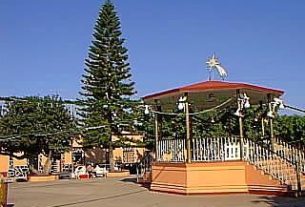The vast majority of the approximately 50,000 Mexican citizens who practice Judaism via organized congregations are descendents of people who, from 1881 to 1939, found life-saving refuge in this country. Unlike the ancestors of many who migrated to the U.S. to avoid military service or seek better economic opportunity, most who came to Mexico were fleeing to save their lives. This has left a legacy of fear, buried in the minds and hearts of the present community of Mexican Jews. Can it happen here? That Mexico, a 97 percent Catholic country, ever became a haven for Jews, is in itself remarkable. By and large, it is a tribute to kindness and tolerance on the part of Mexicans and bears witness to the ability of Jews to adapt to new environments.
Determining the exact number of practicing Jews in Mexico is difficult. The main source of figures is the Comite Central Israelita de Mexico A. C.. Located in Mexico City, this organization serves as an overall liaison body between Jewish congregations all over the Republic. However, since all of the existing synagogues are either Orthodox or Conservative, the Comite has no contact with Jews who might affiliate with a Reformed congregation, if one existed, or with those who consider their Judaism cultural rather than religious.
The official Mexican census sheds little light on the actual number of Jews in the country. They classify as Israelites both Jews and Protestant sects. Additionally, there are some Mexicans of mixed Indian and European ancestry who profess Judaism. Some scholars claim those who worship in the Iglesia de Dios and the Casa de Dios might well be included in the total count. Both read the Old Testament and observe some of the rules that regulate the lives of observant Jews. Others note that Seventh Day Adventists do likewise. More research is necessary before they can be considered to be practicing a form of Judaism. However, there is a well-established synagogue in Venta Prieta that serves Mexican Indians who definitely observe Judaism. Charges brought by the Inquisition substantiate that Jews who fled to Nueva Espagna in 1531, did convert Indians before the Inquisition was established in the New World. However, neither the rabbinate nor the rest of Mexican Jewry recognize any of these three groups.
Presently, there is no official anti-Semitism visible in Mexico Evidence of the attitude of the modern Mexican Government is plentiful. Jews serve and have served in high government positions. The United States, Canada and Great Britain have felt free to send Jews as ambassadors and consuls general. Those in power have welcomed them all. Artists, authors, entertainers, journalists, entrepreneurs, native born or foreign nationals, professing Judaism, have thrived. Even the closed ranks of bullfighters opened their arms to a Brooklyn-born Jew, Sidney Franklin, who in the early 1920’s became a popular matador and remained in Mexico after he “cut the pigtail” as an announcer of bullfights, on the radio and later on television.
In the past, the main problems facing Mexican Jews have been intermarriage and migration out of the country. Now, beginning in the late 1990’s, another one is emerging.
Since 1994, a group named Kulanu, a Hebrew word meaning “all of us.” has started to explore other aspects of Judaism, south of the Rio Grande. One of the principal subjects of their investigation is the status of the “Conversos.” They have started to seek out such groups who, without the blessings of the Rabbinate, have returned to Judaism. Based in the United States, the group is attempting to close the schisms between the descendents of those who suffered forced baptism and the organized Mexican-Jewish community.
As of early 1999 they have made contact with “Converso” groups in Vera Cruz and Puebla who now practice Judaism. Going beyond seeking out those who know about their Jewish background, they are also gathering information about the many devoutly Catholic families who practice some Jewish rites. When questioned as to why they do so, the typical answer of these families is, “because my mother was taught to do so by her mother who in turn learned it from her mother who learned it from her mother.” They may light candles on Friday night or keep separate sets of dishes for dairy and meat, but have no idea that what they are doing is Judaic in origin.
Lecturing at the Spertus Institute in 1995, Schulamite C. Halevey, herself the descendant of a family that left Spain in 1492 and later made its way to Israel, reported on this. She details a legend prevalent among anusim, a Hebrew word meaning “people who suffered forced baptism.” They tell their children,” We are not really Mexican. We are descendants of Spanish nobility.” Thus, they follow “Jewish” rituals, such as observing dietary laws that prohibit mixing of milk and meat, slaughter chickens by cutting the throat, avoid pork, light candles on Friday night. Some close their businesses on Saturday. Questioned about this particular practice, they answer, “It is a day we spend with our families.”
Perhaps without knowing it, they are observing the Jewish Sabbath. Too, they have been taught to marry only others who observe these same “noble” traditions. Without realizing it, they are attempting to preserve memories of a Hebraic heritage that has lain dormant for centuries. Members of Kulanu bear witness to many such situations. One of their goals is to fan whatever latent sparks of Judaism they discover. It is this effort that may cause problems for the Jewish community. Probably, trying to convince anusim to return to Judaism will not succeed. It is hard to visualize large numbers abandoning the Catholicism they have practiced for generations. But, they are becoming aware of their connections to the religion of their ancestors. Many seem interested in learning about such backgrounds. But the interest is academic. They are Catholics. Perhaps it will result in a reservoir of good-will for practicing Jews. On the other hand, it may stir up resentments.
Kulanu is also attempting to convince organized Mexican Jewry, that those who do wish to return to Judaism should be accepted. To date, the answer is “no.” Perhaps there is still some resentment among Mexican Jews against those who, they feel, abandoned their religion under pressure. There is no question that such attitudes prevailed in 1492, the time of the expulsion from Spain. Those who fled used the term “Marranos”, meaning “swine” to describe those who converted. But perhaps the strongest reason that present day Mexican Jews prefer to ignore this pool of “latent Judaism” is mainly to avoid antagonizing the Catholic Church, fearing an up-surge of anti-Semitism.
They are probably right. Thus, the people from Kulanu, attempting to convince some anusim to return to the religion of their ancestors, are really not welcome. Orthodox Jews do not proselytize. They insist that only those born of a Jewish mother are Jewish. Additionally, the rite of circumcision the historical mark of the “covenant” between Jews and Jehovah, is a deterrent to adult males who might consider conversion. Adding up all these factors, a warm welcome for anusim returning to Judaism seems highly unlikely. All but two of the 23 synagogues in Mexico City are Orthodox and in light of Orthodox views on who is a Jew, it is likely that their point of view about anusim will prevail.
Until 1990, very little attention had been paid to the history of Jews in Mexico. A book published in Israel, researched by Joan Comay with the assistance of the Nahum Goldman Museum of the Jewish Diaspora, devotes only one and a half pages to Jewish settlement in all Latin America and mentions Mexico only in listing places where Jews have settled. Called “The Diaspora Story” it deals with the Jewish experience all over the world since the “Babylonian Captivity” but falls short when it comes to discussing how Mexican Jews function in the final decades of the 20th Century.
Until 1995, the most complete study of the Jewish experience in Mexico was published by the University of Mexico in collaboration with the Tribuna Israelita and the Comite Central Israelita de Mexico. Titled Imagenes de un Encuentro and sub-titled “La Presencia Judia en Mexico Durante LaPrimera Mitad del Siglo XX, it is in Spanish and as the subtitle says, deals only with the first half of the century. It portrays a vibrant Jewish community, apparently well integrated into Mexican society, but with a higher carryover of their religion into everyday life than is found in most other Jews who live in the Diaspora.
But Mexican Judaism is not monolithic. Actually, there are four different communities, based on places of origin. Those from Aleppo, Damascus, the Balkans and Eastern Europe, each have their own synagogues. The gulf between Ashkenazim from Russia, Poland, Germany and other parts of Europe and Sephardim, mainly from Italy and what was once the Ottoman Empire, remains.
An Ashkenazi mother of our acquaintance, complaining about her son’s intermarriage, finally revealed that he was marrying a Sephardic girl. Ultimately, her complaint was narrowed down to the fact that the new bride did not cook the same foods the boy grew up eating. But there are probably other reasons she might not have been willing to admit. It is possible that the Ashkenazim, most of whom trace their residence in Mexico back to the 1880’s, are somewhat prejudiced against later arrivals. Eastern European Jews in the United States faced the same attitude. There, the older German-Jewish Community looked down on them. The original problem that kept the groups separate, was language. The Ashkenazim spoke Yiddish among themselves, the Sephardim spoke Ladino. Today, they all speak Spanish, but still retain separate identities and resist inter-marriage.
In 1995, a movie titled “A Kiss to This Land” directed by Daniel Goldberg, a Mexican Jew, was shown at the San Francisco Bay Area’s Jewish Film Festival. The film recreates the Mexico that Jewish immigrants found when they arrived in the 1920s and 1930s. It points out differences between the Jews who settled in the U.S. and those who settled in Mexico. The producer contends that Mexican Jews feel their Jewish heritage much more strongly than American Jews and shows how it affects their everyday lives. The film captured the attention of scholars, both Jewish and non-Jewish, and in the last four years, the Jewish experience in Mexico has been explored and is now the subject of numerous books in English.
Next, in the final part of this series, we will examine in detail how the Jewish community in Mexico copes with its main problems and take a look into its future, as they themselves see it




My ancestors lived in Nonuava Chihuahua . They are Cano a derivative of Cohen according to an article. I had a DNA and showed 5% Eastern Europe